AVA urges people not to feed pigeons amid a sharp rise in feedback about the birds
There was a 34 per cent increase last year in the amount of feedback about pigeons.
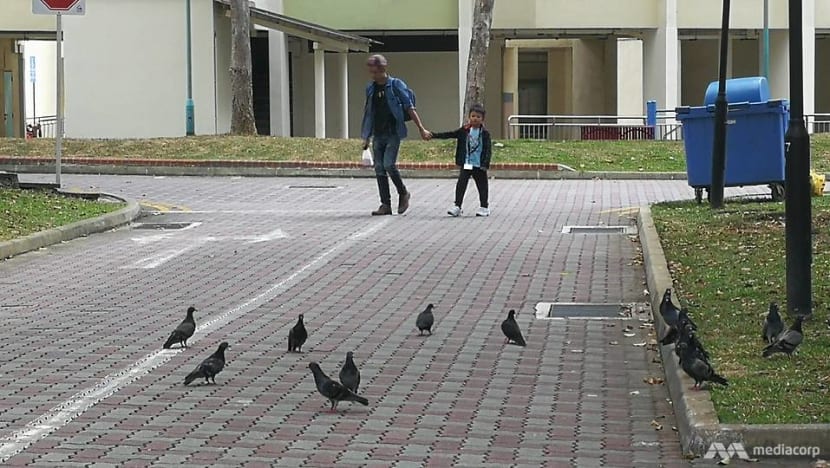
Pigeons in Hougang Ave 1. (Photo: Jalelah Abu Baker)
SINGAPORE: Drying clothes outside your home is a mundane task for most people, but not for Mdm Margaret Tan, who lives in a ground floor HDB flat in Balam Road.
The 66-year-old retiree simply cannot do that. She has tried, but the clothes she took in were dirtier than before they were washed, with bird droppings on them. Mdm Tan lives in an area which has been affected by pigeon-related problems for years.
Nearby is a big banner that urges residents not to feed pigeons by showing examples of problems they could cause - hygiene issues, attracting pests and the spreading of diseases.
But still, people feed the pigeons, she said. While the problem has improved, it still exists, Mdm Tan said.
“I’ve written in to complain about the issue many times,” she said, but has now given up.
When contacted, Marine Parade Town Council, which oversees the area, said it is aware of the ongoing pigeon issues on the estate and that it has been continuously working with the Agri-Food and Veterinary Authority (AVA) to address them.
AVA told Channel NewsAsia it has received 16 cases of feedback on pigeon feeding at Balam Road since 2015.
However, these numbers represent a tiny proportion of the island-wide statistics, which show that there is growing concern about pigeons: Last year, the AVA received 5,500 pieces of pigeon-related feedback from across Singapore, a 34 per cent increase from 4,100 in 2016.
The HDB flats at Balam Road were recently given a fresh coat of paint, but when Channel NewsAsia visited the area, pigeon droppings had already dirtied some ledges.
When asked about what is being done to address the root problem of the pigeons making a mess, a spokesperson for the town council said: “As part of our Repairs and Redecoration (R&R), we are exploring mitigating measures such as using wire mesh and aluminium flashings to deter pigeons from roosting at these areas."
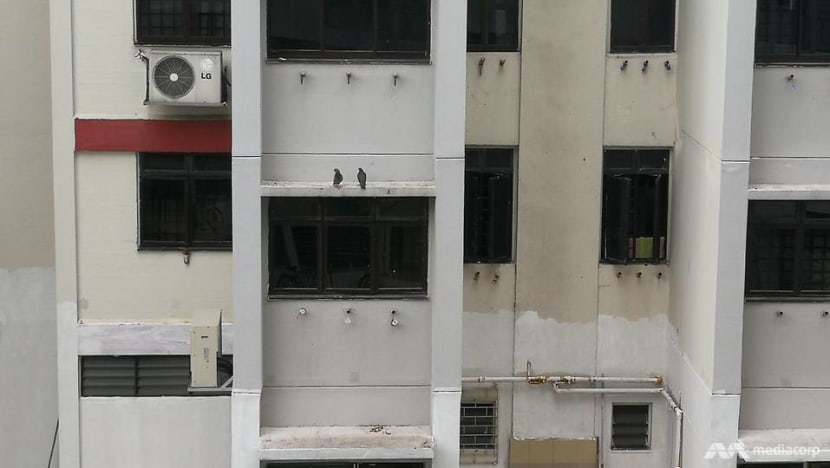
Such repairs and redecoration, which typically include upgrading of bin chutes and washing and painting of external walls, are undertaken by town councils to revitalise an estate.
“We had also received feedback from residents on pigeon feeders in the estate. This availability of food source attracts the birds to congregate in the area. As such, we would like to remind residents to refrain from feeding the pigeons and to maintain the cleanliness of the environment,” the spokesperson added.
AVA WORKING WITH TOWN COUNCIL TO IDENTIFY HOTSPOTS
AVA has been working with Marine Parade Town Council (MPTC) to identify pigeon hotspots at Balam Road, to reduce the population there and maintain hygiene and cleanliness, an AVA spokesperson said.
The authority also works with other agencies to take action against high-rise litterers, who throw food from their homes to feed the pigeons, it said.
Pigeons dirty the environment with droppings, and leftover food from pigeon feeding may attract other pests like rats, which carry diseases and pose a risk to public health, AVA added.
"Feeding encourages pigeons to breed and results in an increase in their population," a spokesperson said, adding that feeders provide a regular source of food which may have led to pigeons congregating in the area.
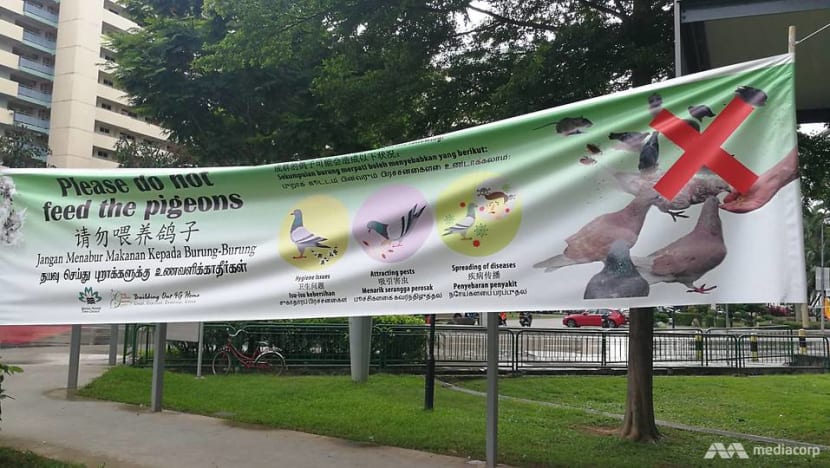
AVA has been educating the public against pigeon feeding as it is an offence, it said. Anyone caught feeding pigeons can be fined up to S$500 under the Animals and Birds Act.
While AVA continues to work with stakeholders to manage the pigeon population, "members of the public can play their part by not feeding pigeons", AVA said.
Another place which has pigeon problems is Hougang.
After receiving feedback from a reader, Channel NewsAsia visited the area. Pigeons stood atop tree branches and on the roofs of shelters, flying as a flock from one spot to another. Dried bird droppings dotted pathways.
Online seller Joseph Goh said that the problem has been around for several years, and that he complained about about the issue twice, more than a year ago, but he felt nothing had been done.
“The pigeons are a nuisance, and their droppings on the ground can look very unsightly sometimes,” he said. He added that there are feeders who pack food just for the pigeons.
Channel NewsAsia reached out to Aljunied-Hougang Town Council on the matter.
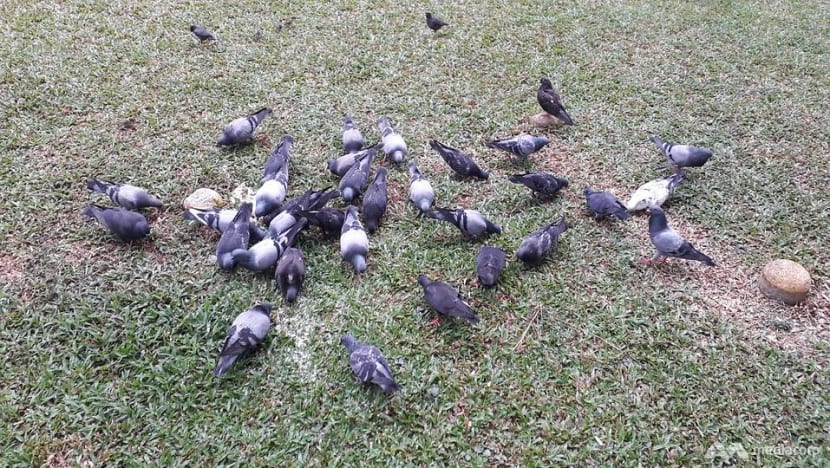
ACCUMULATED PIGEON DROPPINGS CAN BE "QUITE SUBSTANTIAL"
Business development manager at bird control company Mastermark Gloria Ngoi said that pigeons and their droppings are definitely a problem in Singapore.
Ms Ngoi, who has been in the industry for eight years, said: “It may also be a problem when it comes to controlling the number of pigeon feeders. It’s a bit tricky to manage.”
The people who feed the birds may get into a habit, thinking they are doing good for the pigeons, she explained.
As well as the problem of pigeon feeding, the birds are highly adaptable, allowing them to thrive in urban areas, she said.
"With the number of high rise buildings in Singapore, air-conditioning compressor ledges have become a conducive nesting ground for pigeons as it provides sufficient warmth and security away from predators."
She has received distressed calls from home-owners who are unable to open their windows because of the smell of pigeon droppings, which can accumulate to be “quite substantial” over time.
In order to break the pigeon’s nesting habits, one solution is installing bird netting that prevents pigeons from landing on the ledge. Another strategy is using bird spikes which are designed not to allow pigeons to land.
Ms Ngoi said that feeding pigeons with contraceptives can also be an effective strategy to in deal with the issue.
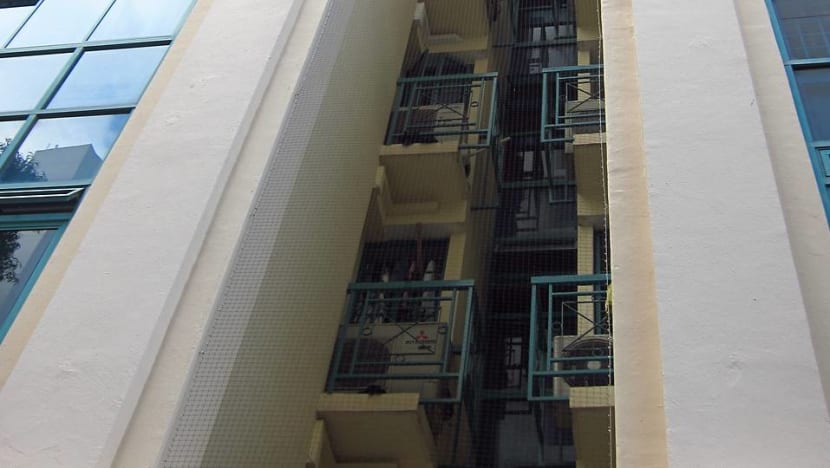
PIGEONS POSE HEALTH AND OTHER RISKS
Other than being smelly, bird droppings can pose health risks as well. Infectious diseases specialist at Mount Elizabeth Novena Specialist Centre Leong Hoe Nam said bird droppings can cause lung, blood or brain infection, pneumonia and fungal infections.
Ms Ngoi agreed that constant exposure to pigeon droppings could cause respiratory problems
They also create other problems. “Their droppings are aesthetically damaging and corrosive. It may eat into paintwork, into concrete, and can eventually eat into metal as well,” Ms Ngoi said.
That said, she finds that more HDB blocks and markets are being bird-proofed over the years. “When town councils go through R&R, they do improve bird control,” she said.
GOVT AGENCIES COLLABORATING TO HELP WITH SUCH PROBLEMS
Minister for Culture, Community and Youth Grace Fu, who oversees the Municipal Services Office (MSO), brought up pigeon issues during the Committee of Supply debate last month.
In explaining the MSO’s behind-the-scenes work on improving inter-agency processes, she brought up the example of these birds.
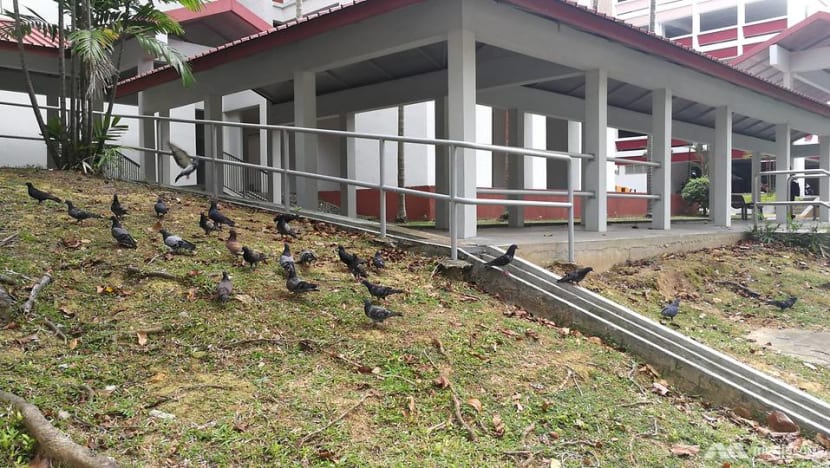
“These agencies work together in order for pigeon-related issues to be
resolved holistically. To support their efforts, MSO has helped to formulate end-to-end workflows to clarify roles and responsibilities, and tighten coordination in their handling of such pigeon-related nuisance,” she said.
In the meantime, residents hope that their neighbours will stop encouraging pigeons by feeding them.
Mdm Tan, who has lived at her Balam Road home for almost 50 years, said: "They (residents) come down and feed them bread and rice even though there's a banner asking them not to. Things will get better if they stop."














